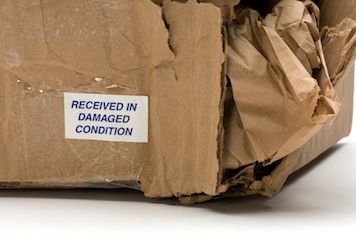REDWOOD LOGIN
Redwood PortalLTL
SCS
SCS Support
Rockfarm

A leading source of frustration for many shippers in 2018 was concealed damage. Besides the negative impact it can have on bottom line profits it can also cause additional issues that can lead to loss of sales, frustrated customers, and disruption of service. While filing a concealed damage freight claim might recoup the damaged commodity, there are some things they don’t cover.
In this blog post, we are going to talk about reducing concealed damage. As such, here are three key ways to address concealed damage issues from last year, and to be proactive in reducing the potential of them occurring this year.
Whether you’re a frequent shipper or move freight on an inconsistent basis, the potential of concealed damage is a reality we all must face. For those who are not aware, concealed damage is defined as freight that may have been damaged during the transit but was not noted on the proof of delivery or shipping bill of lading. When damage occurs during a shipment it is typically recorded by the carrier, as this will likely be covered by shipping insurance programs. When the damage is not noted but discovered upon delivery, it opens up a can of worms.
Anyone who ships products via LTL or FTL understands that damage can happen – regardless of what you do to protect the freight. However, there are three specific items that you can focus on that might reduce the potential of concealed damage and expedite concealed damage freight claims if this occurs to you.
As a shipper, you’re likely sending your products or commodities to a customer. If the customer calls you to indicate that their freight arrived damaged on their dock, the first thing that any shipper should do is contact the carrier immediately. When the damage has not been noted on the proof of delivery (POD), it is the responsibility of the company paying the carrier to contact them as soon as possible. Each carrier has different and unique regulations for processing concealed damage freight claims with respect to the time requirements, so it’s always a good idea to ask the carrier before setting up your shipment about their regulations. If you use a 3PL or freight forwarding company, you should contact them first and let them deal with the carrier.
There is a common statement that many carriers will say upon learning about a concealed damaged freight claim is “prove it”. This is why proactive and smart shippers and receivers understand the value of recording and documenting every detail of the received concealed damage. Doing so, will help you create a paper-trail and provide photographic or video evidence to carriers and their insurance providers. There are a few specific items that need to be documented in order to successfully process a concealed damaged freight claim in most cases including:
The condition of the shipment
When items are shipped and received on a pallet, make sure to take pictures of the complete pallet (from multiple sides). This will allow you to document if damage has occurred to the pallet, which is typically the root reason why the freight has been damaged in the first place.
The packaging
When your items have been delivered damaged in a cardboard box, the recipient should always take pictures or video of the damaged boxes before opening. This will prove that the packaging itself was received damaged. While opening, make sure to continue recording or taking photos to document any damage to the products contained.
The Delivery Vehicle
It’s also a great idea to document the vehicle that delivered the products. A few specific items to record may include the name of the trucking or delivery company, a truck or container number, license plate, and even a description of the driver.
The truth is that concealed damage is usually discovered by the recipient of freight. As such, arguably the most important step is to send a detailed set of instructions for documenting concealed damage freight to all customers.
Being proactive about documenting facts about the concealed damage is the key to ensuring your concealed damage claims are processed quickly. Working with a professional 3PL is a great way of reducing the stress and frustration associated with concealed damage freight claims, as they will handle all communication with the carriers – and can in most cases, expedite the processing of damage.